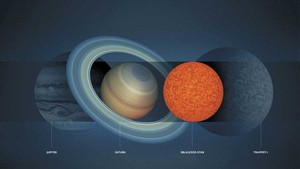
About 30% smaller than TRAPPIST-1, EBLM J0555-57Ab is slightly larger than Saturn and 85 times the mass of JupiterUniversity of Cambridge
Slightly larger than Saturn and 85 times the mass of Jupiter, the celestial object known as EBLM J0555-57Ab is the smallest star ever identified and measured (Astronomy & Astrophysics, in press). Located roughly 600 light-years from Earth, EBLM J0555-57Ab is the smaller of two stars in a binary system. Its mass is equivalent to 8% of the Sun and is similar to that of another star, called TRAPPIST-1, whose system contains seven rocky planets, three of which are in the so-called habitable zone where life could theoretically develop. Its radius, however, is 30% smaller than that of TRAPPIST-1, and its gravitational force is about 300 times greater than Earth’s. The international team of astrophysicists involved in the discovery believe it will be difficult to find a smaller star than EBLM J0555-57Ab. “Our research reveals how small stars can be,” says Alexander Boetticher, a master’s student from the Institute of Astronomy at the University of Cambridge in the UK and first author of the article describing the celestial object. “Had this star formed with only a slightly lower mass, the fusion reaction of hydrogen in its core could not be sustained, and the star would instead have transformed into a brown dwarf.” Dim and cool, a brown dwarf is an astronomical object with a mass somewhere between that of a planet and that of a star. EBLM J0555-57Ab was classified as an ultra-cool dwarf, like TRAPPIST-1. It was found by the Wide Angle Search for Planets project (WASP), which searches for exoplanets in our galaxy and is coordinated by the British universities of Warwick, Keele, Leicester, and Saint Andrews.
Republish